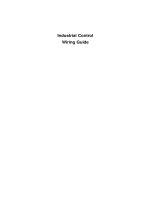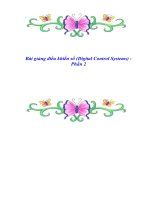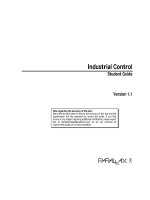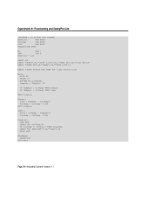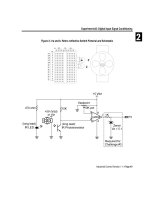Industrial Control Wiring Guide 2 2010 Part 2 doc
Bạn đang xem bản rút gọn của tài liệu. Xem và tải ngay bản đầy đủ của tài liệu tại đây (64.56 KB, 10 trang )
1. SAFETY
1.2. Building safe equipment
The second aspect of safety concerns the requirement
to:
᭹ design, construct and use electrical equipment so
that it is safe and does not give rise to danger
even should a fault occur.
The designer of the equipment will have taken into
account all these concerns in specifying the parts to be
used, the wire types and colours, the type of enclosure
and so on. Our part comes in ensuring that:
᭹ no parts are to be substituted without an
engineering change notice;
᭹ manufacturers’ instructions for any component
must be followed.
Both of these aspects are statutory requirements laid
down in law in a number of regulations.
1.2.1. The Health and Safety at Work Act
(HSAW)
This is a wide-ranging Act of Parliament covering all
aspects of safety at work. It has gradually replaced the
Factories Act.
The HSAW allows for the introduction of regulations to
control particular aspects of safety at work. These
regulations, which must be complied with, are often
produced because of European Directives, which in
turn are designed to harmonise the safe working con-
ditions for all members of the European Community.
Among the many regulations within the Act, some
have a direct influence on the machinery control
panels which we are interested in, for example:
᭹ The Electricity at Work Regulations 1989.
᭹ The Provision and Use of Work Equipment.
᭹ The Supply of Machinery (Safety) Regulations.
᭹ The Electrical Equipment (Safety) Regulations.
These affect other areas of safety besides those which
concern us here and it is outside the scope of this book
to go into any real detail on them. However, you may
find it useful to consider how they affect the way we
build these panels and the components we use in them.
1.2.2. Standards
A standard is a document specifying nationally or
internationally agreed properties for manufactured
goods and equipment.
Regulations and standards are two different things:
regulations are the law and must be complied with;
standards on the other hand are advisory. They are
closely linked together.
Equipment sold in the EEC must be ‘CE marked’ to
show that it complies with the regulations that are
concerned with its safety. As part of this process the
manufacturer must show how the risks and hazards
that the equipment will present have been overcome or
protected against. This information is placed in the
Technical Document of the equipment so that it can be
inspected should there be a query by the authorities
regarding the equipment’s safety or performance.
The best way to show compliance with a regulation is
to use recognised standards in the design and con-
struction of the product, thereby fulfilling the require-
ments of the regulation.
The British Standards Institute (BSI), as well as other
European and international bodies, publish standards
which give recommendations and guidance on –
amongst other things – the selection and use of various
electrical components and cables.
There are three types of standards that are important to
us:
᭹ British Standards (BS),
᭹ European Harmonised Standards (EN or BS EN),
᭹ International Standards (IEC).
These are of course mainly the concern of the designer
but it is as well to be aware that they exist, as it may
explain why one component is used instead of another
and why only those components designated in the
parts list must be used.
Standards of most importance to us are:
᭹ BS EN 60204 – Safety of Machinery – Electrical
Equipment of Machines,
᭹ BS EN 60947 (IEC947) – Low Voltage Switch-
gear and Controlgear (7 Parts).
4
1. SAFETY
BS EN 60204 covers the way in which the electrical
equipment should be constructed and includes every-
thing from the selection of components, through the
sizes, types and colour of the wiring, to the electrical
tests that should be done on the finished equipment.
Within BS EN 60204 there are references to other
standards, including BS EN 60947, that will give more
detail on individual parts or components.
BS EN 60947 and the international standard IEC 947
are in seven parts, giving the specification and other
requirements of the individual components we will
use in the equipment.
᭹ Part 1: General Requirements. Defines the rules
of a general nature to obtain uniformity in
requirements and tests.
Each of the following parts deals mainly with the
characteristics, conditions for operation, methods for
testing and marking requirements of the various
electrical components.
᭹ Part 2: Circuit-breakers.
᭹ Part 3: Switches, disconnectors, switch-discon-
nectors and fuse combination units.
᭹ Part 4: Contactors and motor starters including
short circuit and overload protection devices.
᭹ Part 5: Control circuit devices and switching
elements.
᭹ Part 6: Multiple function equipment such as that
used for automatic emergency power switching.
᭹ Part 7: Ancillary equipment such as terminal
blocks used to connect copper conductors.
Basically our control equipment panels should be built
to conform to the requirements of BS EN 60204 using
components manufactured to conform to the require-
ments of BS EN 60947 and other related component
standards and approvals.
An approved component is one whose manufacture
and performance has been checked and proven to meet
the specifications set by the standards authority of an
individual country. For example, a part approved in
the UK would be ‘BS approved’. These approvals may
be important if the equipment is to be exported.
Some other standards authorities are:
᭹ USA ANSI – approvals are made by the
Underwriters Laboratory and marked UL.
᭹ Canada, CSA.
᭹ Denmark, DEMKO.
᭹ Italy, CEI.
᭹ Norway, NEMKO.
᭹ Germany, DIN/VDE.
᭹ France, NF/UTE.
᭹ Europe, CENELEC.
Some other BSI documents
᭹ PD 2754: Parts 1 and 2. Published document.
Construction of electrical equipment for protec-
tion against electric shock. Part 1 deals with the
classification of electrical and electronic equip-
ment with regard to protection against electric
shock, for example whether it is earthed, double
insulated or uses a safe, low voltage supply. Part
2 is a more detailed guide to the requirements of
the various classes as defined in Part 1.
᭹ BS 7452: Specification for transformers of the
type used in control panels. Equivalent to IEC
989: Control transformer specification.
᭹ BS 3939: Graphical symbols. Provides compre-
hensive details of the symbols to be used in
electrical, electronic and telecommunication dia-
grams. It is published in 12 parts and is broadly
the same as EN 617 – Parts 2 to 12.
᭹ BS EN 60073: Colours for indicator lamps, push
buttons, etc. Provides a general set of rules for
the use of certain colours, shapes, positioning
requirements of indicators and actuators to
increase the safety and operational efficiency of
equipment. BS EN 60204 also provides guide-
lines specific to the electrical controls for
machinery.
᭹ BS EN 60529: Specification for classification of
degrees of protection provided by electrical
enclosures. Also known as ‘IP Codes’, it uses a
5
1. SAFETY
two or three digit number to define to what
degree the enclosure is sealed to protect the
contents against dust, moisture and similar
damaging substances.
᭹ BS 6231: Specification for PVC-insulated cable
for switchgear and controlgear wiring. This deals
with the requirements for the wires and cables
used in the wiring of control panels up to
600 V/1000 V.
1.2.3. The IEE regulations (BS 7671)
The Institute of Electrical Engineers publishes its
Regulations for Electrical Installations, which cover
the design, selection and construction of electrical
installations in buildings generally, and provide guid-
ance for safety in the design and construction of
electrical equipment. Although mainly concerned with
electrical systems in buildings, the information is
applicable to machine control panels because they will
be connected to the building’s electrical system. These
are now published as BS 7671.
In addition there are:
᭹ Guidance Notes from the Health and Safety
Executive.
᭹ Specifications and Regulations from the Depart-
ment of Trade and Industry, BSI and the Institute
of Electrical Engineers.
You may be interested to know that all the standards
referred to here concern ‘low voltage’ equipment.
Low voltages as defined by the IEE are those up to
and including 1000 volts AC or 1500 volts DC.
6
2. DRAWINGS
2.1. Types of drawing
We use drawings to convey the information about a
piece of equipment in a form which all those involved
in its production, installation and service will under-
stand. To make this possible, standard drawing
conventions have been adopted by most companies.
᭹ This book will emphasise the British Standard
symbols as defined in BS 3939. Other symbols
which may be in common use will also be
shown.
The information we need to be able to assemble the
equipment will be only one item in the set of drawings
and schedules which make up the complete design.
2.1.1. Circuit diagram
This shows how the electrical components are con-
nected together and uses:
᭹ symbols to represent the components;
᭹ lines to represent the functional conductors or
wires which connect them together.
A circuit drawing is derived from a block or functional
diagram (see 2.1.4.). It does not generally bear any
relationship to the physical shape, size or layout of the
parts and although you could wire up an assembly from
the information given in it, they are usually intended to
show the detail of how an electrical circuit works.
2.1.2. Wiring diagram
This is the drawing which shows all the wiring
between the parts, such as:
᭹ control or signal functions;
᭹ power supplies and earth connections;
᭹ termination of unused leads, contacts;
᭹ interconnection via terminal posts, blocks, plugs,
sockets, lead-throughs.
It will have details, such as the terminal identification
numbers which enable us to wire the unit together.
Parts of the wiring diagram may simply be shown as
blocks with no indication as to the electrical compo-
nents inside. These are usually sub-assemblies made
separately, i.e. pre-assembled circuits or modules.
7
2. DRAWINGS
2.1.3. Wiring schedule
This defines the wire reference number, type (size and
number of conductors), length and the amount of
insulation stripping required for soldering.
In complex equipment you may also find a table of
interconnections which will give the starting and
finishing reference points of each connection as well
as other important information such as wire colour,
ident marking and so on.
2.1.4. Block diagram
The block diagram is a functional drawing which is
used to show and describe the main operating
principles of the equipment and is usually drawn
before the circuit diagram is started.
It will not give any real detail of the actual wiring
connections or even the smaller components and so is
only of limited interest to us in the wiring of control
panels and equipment.
2.1.5. Parts list
Although not a drawing in itself, in fact it may be part
of a drawing. The parts list gives vital information:
᭹ It relates component types to circuit drawing
reference numbers.
᭹ It is used to locate and cross refer actual
component code numbers to ensure you have the
correct parts to commence a wiring job.
8
2. DRAWINGS
2.2. Symbols
2.2.1. Conductors
1. General symbol, conductor or group of
conductors.
2. Temporary connection or jumper.
3. Two conductors, single-line representation.
4. Two conductors, multi-line representation.
5. Single-line representation of n conductors.
6. Twisted conductors. (Twisted pair in this
example.)
7. General symbol denoting a cable.
8. Example: eight conductor (four pair) cable.
9. Crossing conductors – no connection.
10. Junction of conductors (connected).
11. Double junction of conductors.
12. Alternatively used double junction.
9
2. DRAWINGS
2.2.2. Connectors and terminals
13. General symbol, terminal or tag.
These symbols are also used for contacts with
moveable links. The open circle is used to represent
easily separable contacts and a solid circle is used for
those that are bolted.
14. Link with two easily separable contacts.
15. Link with two bolted contacts.
16. Hinged link, normally open.
17. Plug (male contact).
18. Socket (female contact).
19. Coaxial plug.
20. Coaxial socket.
2.2.3. Inductors and transformers
21. General symbol, coil or winding.
22. Coil with a ferromagnetic core.
23. Transformer symbols. (See the components sec-
tion for further variations.)
10
2. DRAWINGS
2.2.4. Resistors
24. General symbol.
25. Old symbol sometimes used.
26. Fixed resistor with a fixed tapping.
27. General symbol, variable resistance
(potentiometer).
28. Alternative (old).
29. Variable resistor with preset adjustment.
30. Two terminal variable resistance (rheostat).
31. Resistor with positive temperature coefficient
(PTC thermistor).
32. Resistor with negative temperature coefficient
(NTC thermistor).
11
2. DRAWINGS
2.2.5. Capacitors
33. General symbol, capacitor. (Connect either way
round.)
34. Polarised capacitor. (Observe polarity when mak-
ing connection.)
35. Polarised capacitor, electrolytic.
36. Variable capacitor.
37. Preset variable.
2.2.6. Fuses
38. General symbol, fuse.
39. Supply side may be indicated by thick line:
observe orientation.
40. Alternative symbol (older).
12
2. DRAWINGS
2.2.7. Switch contacts
41. Break contact (BSI).
42. Alternative break contact version 1 (older).
43. Alternative break contact version 2.
44. Make contact (BSI).
45. Alternative make contact version 1.
46. Alternative make contact version 2.
47. Changeover contacts (BSI).
48. Alternative showing make-before-break.
49. Alternative showing break-before-make.
13
